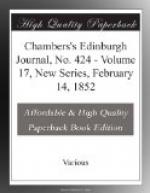So extremely meagre was the news, both foreign and domestic, that a considerable portion of the four small pages of the Chronicle was usually devoted to literature. Extracts were frequently given from the works of Johnson, Smollett, and other popular writers, and a column was often occupied by an essay from a contributor to the paper, generally treating of some social evil or peculiarity, but never intermeddling with local or general politics. These effusions displayed a very respectable amount of ability, and the general getting-up, or what would now be termed the sub-editing of the paper, was also performed with care and ability. The scraps of news were always presented rewritten and carefully condensed, instead of the loose ‘scissors-and-paste’ style of publication adopted by many provincial papers of the present day. Notices not only of local theatricals, but of histrionic matters at Old Drury, were occasionally given; the number for March 15, 1766, containing a well-written criticism of ‘The Clandestine Marriage; a New Comedy,’ performed there. As the Chronicle thus had to leave politics for literature, we may perhaps, in our turn, digress from a consideration of its pages, to note briefly that this period was set in the very midst of the celebrated Georgian era, in which this country could boast of more distinguished men—especially in literature—than at any other period. In about twenty previous years, many great ones had departed—notably Pope, Thomson, Fielding. Richardson also had died in 1761, and Shenstone in 1763; the author of the Night-Thoughts survived till 1765, when his burial was announced in the Chronicle of April 27. At this time (1765-6), Dr Johnson had reached the zenith of his fame; Gray was becoming popular; Smollett had written most of his novels; Goldsmith was about to present the world with his exquisite Vicar of Wakefield; Gibbon had returned to England from Rome with the idea of The Decline and Fall floating in his brain; Thomas Chatterton,




